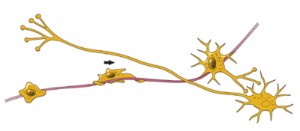The Life of Your Next Neuron

Some neurons migrate by riding along extensions (radial glia) until they reach their final destinations.
(In honor of Brain Awareness Week, which starts today, let’s learn a bit more about neurons. A question we get often as we discuss the benefits of aerobic and mental exercise is, “Can neurons travel -“migrate”- inside the brain?” Below you have the answer, and more, straight from the National Institute of Health website.)
“Once a neuron is born it has to travel to the place in the brain where it will do its work.
How does a neuron know where to go? What helps it get there?
Scientists have seen that neurons use at least two different methods to travel:
- Some neurons migrate by following the long fibers of cells called radial glia. These fibers extend from the inner layers to the outer layers of the brain. Neurons glide along the fibers until they reach their destination.
- Neurons also travel by using chemical signals. Scientists have found special molecules on the surface of neurons — adhesion molecules — that bind with similar molecules on nearby glial cells or nerve axons. These chemical signals guide the neuron to its final location.
Not all neurons are successful in their journey. Scientists think that only a third reach their destination. The rest either never differentiate, or die and disappear at some point during the two to three week phase of migration.
Some neurons survive the trip, but end up where they shouldn’t be. Mutations in the genes that control migration create areas of misplaced or oddly formed neurons that can cause disorders such as childhood epilepsy or mental retardation. Some researchers suspect that schizophrenia and the learning disorder dyslexia are partly the result of misguided neurons.”
To Learn More about The Life and Death of a Neuron at the NIH website:


